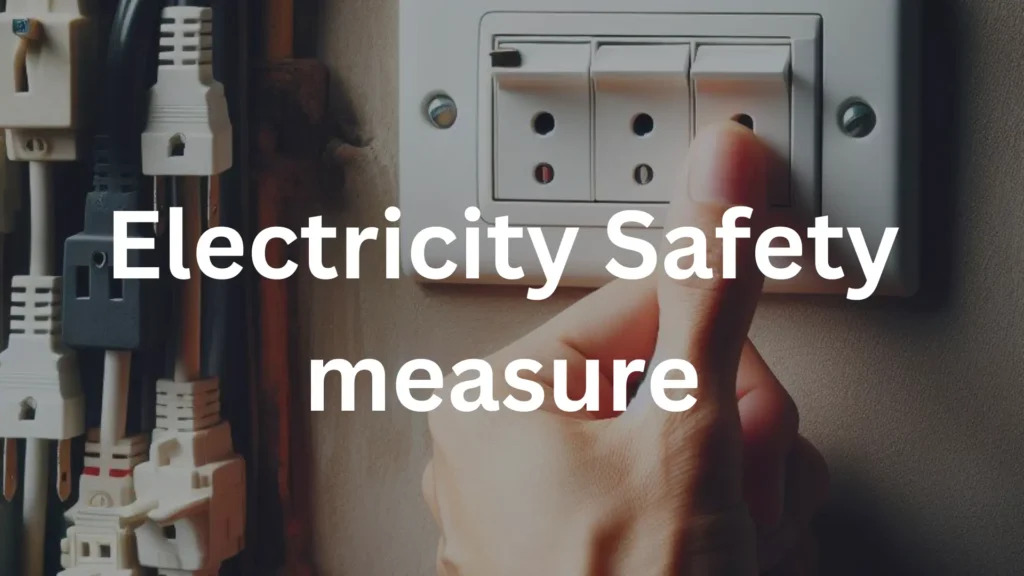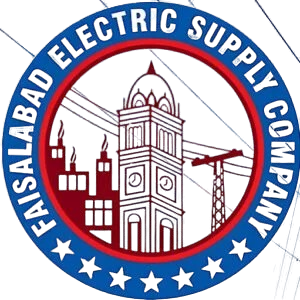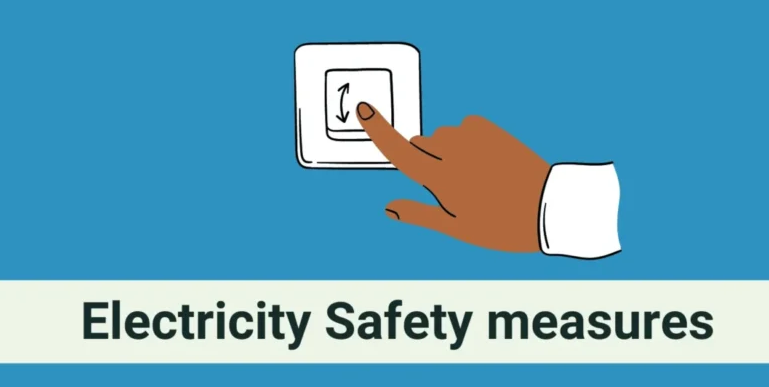Electricity powers nearly every aspect of modern life—from the lights in our homes to the machines that keep businesses running. But while electricity is indispensable, it is also one of the leading causes of household fires, injuries, and workplace accidents. Electricity Safety Measures
According to the Electrical Safety Foundation International (ESFI), more than 50,000 home electrical fires occur each year in the U.S. alone, resulting in hundreds of deaths, thousands of injuries, and over $1.5 billion in property damage. Many of these tragedies are preventable with proper electricity safety measures. Electricity Safety Measures
This guide covers everything you need to know about staying safe around electricity—whether at home, at work, or outdoors. We’ll dive into practical tips, expert insights, and real-life examples to help you protect your loved ones, employees, and property. Electricity Safety Measures
Why Electricity Safety Matters

Electricity is often called a “silent danger” because you can’t see, smell, or hear it until something goes wrong. A single faulty wire or overloaded outlet can spark a fire within seconds. Beyond property damage, electric shocks can cause burns, organ damage, or even cardiac arrest.
For businesses, the stakes are even higher. Workplace electrocutions are among the top four causes of construction fatalities, according to OSHA (Occupational Safety and Health Administration).
Simply put: ignoring electricity safety can cost lives. But the good news is that most accidents can be avoided with preventive measures. Electricity Safety Measures
Common Electrical Hazards to Watch For
Understanding the risks is the first step toward safety. Some of the most common electrical hazards include: Electricity Safety Measures
- Overloaded circuits – Plugging too many devices into a single outlet or extension cord.
- Damaged wiring – Frayed, cracked, or exposed wires that can cause sparks.
- Water exposure – Operating electrical appliances near sinks, pools, or wet surfaces.
- Faulty appliances – Old or poorly maintained devices with internal wiring issues.
- Improper grounding – Lack of grounding increases shock risk.
- DIY electrical repairs – Attempting to fix wiring without proper training.
Each of these hazards can be mitigated with awareness and preventive action.
Home Electricity Safety Measures
1. Inspect and Maintain Wiring Regularly
Electrical systems degrade over time. If your home is more than 20 years old, have a licensed electrician inspect the wiring. Look out for signs like flickering lights, frequent breaker trips, or burning smells near outlets—these are red flags of electrical faults. Electricity Safety Measures
2. Avoid Overloading Outlets
Plugging multiple appliances into one socket with extension cords may seem convenient, but it creates heat buildup that can lead to fire. Instead, use power strips with surge protection and distribute appliances across circuits. Electricity Safety Measures
3. Install Ground Fault Circuit Interrupters (GFCIs)
Bathrooms, kitchens, laundry rooms, and outdoor outlets should have GFCIs. These devices cut off electricity within milliseconds if they detect abnormal current flow, preventing potentially fatal shocks.
4. Keep Water and Electricity Separate
Never use electrical appliances with wet hands or near water sources. For example, a blow dryer near a bathroom sink can quickly turn deadly. Always dry your hands before touching switches or plugs.
5. Childproof Your Home
Children are naturally curious, and unprotected outlets can be life-threatening. Use tamper-resistant receptacles (TRRs) or outlet covers. Teach kids early about the dangers of electricity.
6. Unplug Unused Appliances
Not only does unplugging unused electronics save energy, but it also reduces the risk of short circuits or fires when devices malfunction while unattended. Electricity Safety Measures
Workplace Electricity Safety Measures
Electrical hazards aren’t limited to homes—they’re especially dangerous in workplaces like construction sites, factories, and offices. Electricity Safety Measures
1. Conduct Regular Safety Training
Every employee should know basic electricity safety practices—such as not touching exposed wires, avoiding wet areas, and recognizing warning signs of electrical faults. OSHA requires companies to provide this training. Electricity Safety Measures
2. Use Lockout/Tagout Procedures
Before working on electrical equipment, workers should follow lockout/tagout (LOTO) protocols to ensure power is completely shut off. This prevents accidental electrocution when machines are under repair. Electricity Safety Measures
3. Personal Protective Equipment (PPE)
Workers dealing with electrical systems should wear flame-resistant clothing, rubber gloves, and safety boots. PPE can mean the difference between a minor incident and a fatal accident.
4. Maintain Equipment Properly
Machinery should undergo routine inspections. Damaged cords, overloaded circuits, and faulty connections should be repaired immediately. Electricity Safety Measures
5. Safe Use of Extension Cords
Extension cords are designed for temporary use, not permanent power solutions. For heavy-duty machinery, always rely on hardwired connections installed by licensed electricians.
Outdoor Electricity Safety Measures
Electricity hazards extend beyond walls and workplaces. Electricity Safety Measures
1. Be Aware of Power Lines
Never climb trees or use ladders near overhead power lines. Keep cranes, scaffolding, or tall equipment at least 10 feet away from live wires. Electricity Safety Measures
2. Use Outdoor-Rated Equipment
Extension cords, lights, and tools designed for indoor use are unsafe outdoors. Always check for a “W” or “Weather-Resistant” label before using them outside. Electricity Safety Measures
3. Stay Safe During Storms
Lightning is one of nature’s most dangerous electrical forces. During thunderstorms, stay indoors, avoid touching wired electronics, and never shelter under trees. Electricity Safety Measures
4. Generator Safety
Portable generators must be operated outdoors in well-ventilated areas. Plug appliances directly into the generator with proper cords—never back-feed power into your home’s wiring, as it can electrocute utility workers. Electricity Safety Measures
Expert Tips for Preventing Electrical Fires
Firefighters and electricians consistently emphasize prevention. Some expert-backed recommendations include: Electricity Safety Measures
- Replace outdated circuit breakers with arc fault circuit interrupters (AFCIs) to detect dangerous sparks. Electricity Safety Measures
- Schedule annual electrical inspections for older homes and businesses.
- Keep flammable materials (like curtains and paper) away from heat-producing appliances.
- Label your electrical panel clearly, so circuits can be shut off quickly in an emergency.
Real-Life Example: A Preventable Tragedy
In 2019, a family in Ohio lost their home to an electrical fire caused by an overloaded extension cord powering multiple space heaters. Fire investigators noted that a simple power strip with surge protection—or better yet, separate outlets—could have prevented the fire. Electricity Safety Measures
Stories like this highlight the importance of small, proactive steps in electricity safety.
First Aid for Electrical Shock
Even with precautions, accidents may occur. Here’s what to do if someone suffers an electric shock:
- Do not touch the person while they’re still in contact with electricity.
- Turn off the power source immediately, or use a non-conductive object (like wood) to separate the victim from the current. Electricity Safety Measures
- Call emergency services right away. Electricity Safety Measures
- If the person is unresponsive, begin CPR if trained.
- Treat burns with sterile gauze—avoid applying ointments or ice.
Quick response can be the difference between life and death.
Electricity Safety for Children and Teenagers
Educating young people about electricity should start early. Simple lessons like:
- Never stick objects into outlets.
- Stay away from electrical substations.
- Don’t use phones or electronic devices while charging near water.
Schools can reinforce safety with interactive workshops and real-life demonstrations
Electricity Safety in Modern Smart Homes
With the rise of smart technology, homes are becoming more connected. While smart devices offer convenience, they also introduce new risks. Electricity Safety Measures
- Use certified devices from reputable brands to avoid counterfeit electronics.
- Secure Wi-Fi networks to prevent hackers from tampering with smart electrical systems.
- Update firmware regularly for smart plugs, switches, and appliances.
Frequently Asked Questions About Electricity Safety
What is the most common cause of electrical fires?
The leading cause is faulty or outdated wiring, followed by overloaded outlets.
How often should electrical systems be inspected?
Homes older than 20 years should be inspected every 3–5 years, while businesses should schedule annual inspections.
Is it safe to fix electrical problems yourself?
No. Unless you are a licensed electrician, DIY repairs are dangerous and may void insurance coverage.
Final Thoughts
Electricity is both a powerful tool and a potential hazard. By practicing simple but effective electricity safety measures—from unplugging unused appliances to scheduling professional inspections—you can dramatically reduce the risk of fires, shocks, and fatalities. Electricity Safety Measures
Whether at home, at work, or outdoors, safety starts with awareness and responsibility.
Taking the time to educate your family, employees, and community about electrical safety is not just a precaution—it’s an investment in lives saved. Electricity Safety Measures

